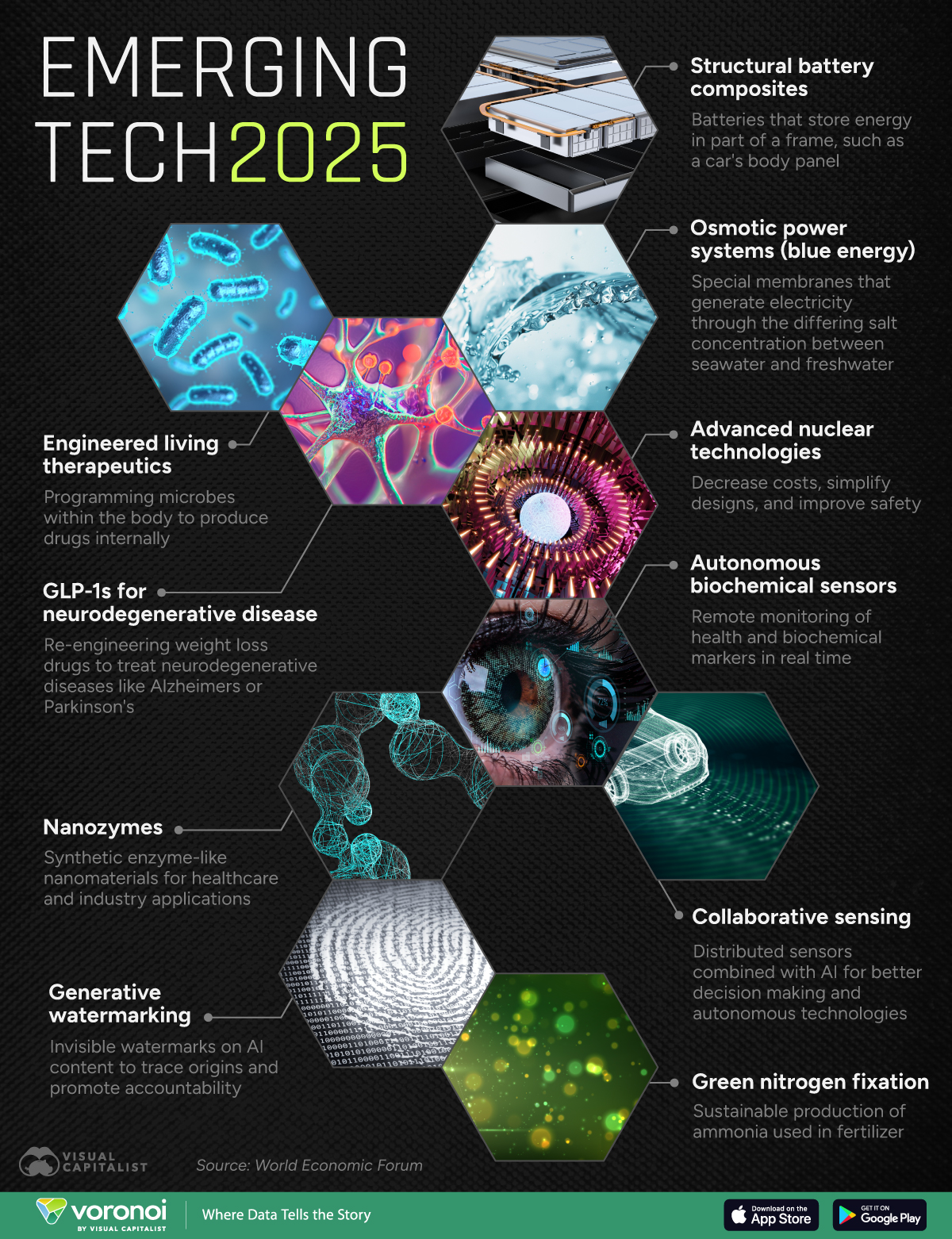Visualizing The Top Emerging Technologies Of 2025
(Click on image to enlarge)

Key Takeaways
- Structural battery composites and collaborative sensing stand among the top emerging technologies of 2025.
- Additionally, engineered living therapeutics are an emerging technology that enable drugs to be produced within the body.
- Technologies that make this list, compiled by WEF, are assessed on their societal impact, depth, and state of adoption.
As innovation accelerates at a breakneck speed, several emerging technologies stand to reshape industries and society.
From health care to materials science, technologies across multiple fields are at a tipping point. While many fail to achieve real-world applications, a select few break through the mold and gain commercial success.
This graphic shows the top 10 emerging technologies of 2025, based on analysis from the World Economic Forum.
The Most Promising Emerging Tech of the Year
In particular, the analysis highlights technologies at an early stage of adoption with the potential to reshape society.
While some of these technologies may still take years to fully commercialize, others are already gaining traction. Below, we show the top 10 emerging tech of 2025:
| Technology | Description |
|---|---|
| 🔋 Structural battery composites | Batteries that store energy in part of a frame, such as a car's body panel |
| 🌊 Osmotic power systems (blue energy) | Special membranes that generate electricity through the differing salt concentration between seawater and freshwater |
| ⚛️ Advanced nuclear technologies | Decrease costs, simplify designs, and improve safety |
| 🧬 Engineered living therapeutics | Programming microbes within the body to produce drugs internally |
| 🧠 GLP-1s for neurodegenerative disease | Re-engineering weight loss drugs to treat neurodegenerative diseases like Alzheimers or Parkinson's |
| 🩺 Autonomous biochemical sensors | Remote monitoring of health and biochemical markers in real time |
| 🌱 Green nitrogen fixation | Sustainable production of ammonia used in fertilizer |
| 🧪 Nanozymes | Synthetic enzyme-like nanomaterials for healthcare and industry applications |
| 📡 Collaborative sensing | Distributed sensors combined with AI for better decision-making and autonomous technologies |
| 🖋️ Generative watermarking | Invisible watermarks on AI content to trace origins and promote accountability |
In the realm of health care, engineered living therapeutics offer a radical new approach: using programmed microbes that can produce medicine within the body itself.
This could revolutionize the treatment of chronic illnesses and dramatically lower the cost of delivering life-saving therapies. Similarly, the rise of GLP-1-based treatments, originally designed for diabetes and obesity, is now showing potential in slowing the progression of neurodegenerative diseases like Alzheimer’s and Parkinson’s.
On the energy front, advanced nuclear technologies, including modular reactors, are gaining momentum as scalable and safer sources of clean energy—vital in the global push to decarbonize.
Meanwhile, collaborative sensing—the use of interconnected sensors to gather real-time data—has applications ranging from smart cities to environmental monitoring, enabling faster and more informed decision-making.
More By This Author:
Visualizing Uber’s Surge In Rides And Users (2015-2024)
Chart: The Plummeting Cost Of Renewable Energy
How Much Revenue Do Tech Giants Earn Per Employee?



